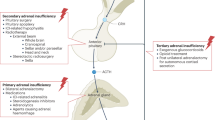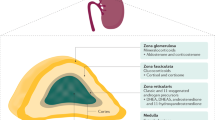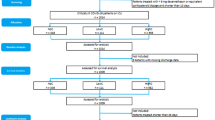Abstract
Critical illness is generally hallmarked by activation of the hypothalamic–pituitary–adrenal axis. The development of very high levels of cortisol has been associated with severe illness and a raised risk of death. Likewise, a response that is inadequate relative to the degree of stress, termed relative adrenal insufficiency (also known as critical-illness-related corticosteroid insufficiency) has been associated with increased mortality. Much controversy exists with regard to the definition and biochemical testing of an adequate adrenal response to critical illness, which hampers diagnosis. High doses of glucocorticoids have been shown to have no effect in this setting and might be harmful. Moderate doses have been advocated, however, for critically ill patients with inflammatory conditions, such as acute respiratory distress syndrome and septic shock syndrome. Initial results from proof-of-concept studies were promising but thus far have not been reproduced in large, multicenter trials, although the latter were underpowered to yield definite conclusions. The role of glucocorticoid therapy in intensive care, therefore, remains uncertain. Until the debate has been settled, we recommend that use of glucocorticoid therapy in critically ill patients should continue to be based on the clinician's judgment and that routine adjuvant use should be avoided.
Key Points
-
An appropriate response of the hypothalamic–pituitary–adrenal axis to the severe stress of critical illness is essential for survival, as both very high cortisol responses and low responses (so-called relative adrenal insufficiency) have been associated with increased mortality
-
The adrenocorticotropic hormone stimulation test is widely used to assess activation of the hypothalamic–pituitary–adrenal axis, albeit without a confirmed optimum dose
-
The concept of relative adrenal insufficiency remains enigmatic as there is no consensus about the accurate biochemical diagnostic criteria by which to identify this condition, particularly since total cortisol response does not necessarily reflect response at the free hormone level
-
Initial studies on moderate-dose glucocorticoid therapy in acute respiratory distress syndrome or septic shock syndrome showed major clinical benefits; larger, multicenter trials did not confirm these results or even suggested harm, but statistical power or design issues hamper solid conclusions
-
Demonstrating a survival benefit for glucocorticoid therapy in critically ill patients is challenging due to the enormous number of patients that would be needed in order to obtain sufficient statistical power, but trial consortia might enable such studies
-
Until the issues surrounding the role of glucocorticoid therapy in critical illness are resolved, physicians should not use these drugs as routine adjuvant therapy, although use as a rescue strategy at the clinician's discretion is acceptable
This is a preview of subscription content, access via your institution
Access options
Subscribe to this journal
Receive 12 print issues and online access
$189.00 per year
only $15.75 per issue
Buy this article
- Purchase on SpringerLink
- Instant access to full article PDF
Prices may be subject to local taxes which are calculated during checkout

Similar content being viewed by others
References
Van den Berghe G et al. (1998) Acute and prolonged critical illness as different neuroendocrine paradigms. J Clin Endocrinol Metab 83: 1827–1834
Vanhorebeek I et al. (2006) Endocrine aspects of acute and prolonged critical illness. Nature Clin Pract Endocrinol Metab 2: 20–31
Venkatesh B et al. (2007) Evidence of altered cortisol metabolism in critically ill patients: a prospective study. Intensive Care Med 33: 1746–1753
White PC et al. (1997) 11β-Hydroxysteroid dehydrogenase and the syndrome of apparent mineralocorticoid excess. Endocr Rev 18: 135–156
Prigent H et al. (2004) Corticotherapy in sepsis. Crit Care 8: 122–129
Venkataraman S et al. (2007) The hypothalamic–pituitary–adrenal axis in critical illness. Rev Endocr Metab Disord 8: 365–373
Prigent H et al. (2004) Mechanisms of impaired adrenal function in sepsis and molecular actions of glucocorticoids. Crit Care 8: 243–252
Cooper MS and Stewart PM (2003) Corticosteroid insufficiency in acutely ill patients. N Engl J Med 348: 727–734
Rivier C and Vale W (1983) Modulation of stress-induced ACTH release by corticotropin-releasing factor, catecholamines and vasopressin. Nature 305: 325–327
Rook GAW (1999) Glucocorticoids and immune function. Baillieres Best Pract Res Clin Endocrinol Metab 13: 567–581
Marik PE and Zaloga GP (2002) Adrenal insufficiency in the critically ill: a new look at an old problem. Chest 122: 1784–1796
Cooper MS et al. (2001) Modulation of 11β-hydroxysteroid dehydrogenase isozymes by proinflammatory cytokines in osteoblasts: an autocrine switch from glucocorticoid inactivation to activation. J Bone Miner Res 16: 1037–1044
Beishuizen A et al. (2001) Patterns of corticosteroid-binding globulin and the free cortisol index during septic shock and multitrauma. Intensive Care Med 27: 1584–1591
Vanhorebeek I et al. (2006) Cortisol response to critical illness: effect of intensive insulin therapy. J Clin Endocrinol Metab 91: 3803–3813
Cooper MS and Stewart PM (2007) Adrenal insufficiency in critical illness. J Intensive Care Med 22: 348–362
Pemberton PA et al. (1988) Hormone binding globulins undergo serpin conformational change in inflammation. Nature 336: 257–258
Hammond GL et al. (1990) A role for corticosteroid-binding globulin in delivery of cortisol to activated neutrophils. J Clin Endocrinol Metab 71: 34–39
Hamrahian AH et al. (2004) Measurements of serum free cortisol in critically ill patients. N Engl J Med 350: 1629–1638
Vermes I and Beishuizen A (2001) The hypothalamic-pituitary-adrenal response to critical illness. Best Pract Res Clin Endocrinol Metab 15: 495–511
Bornstein SR and Chrousos GP (1999) Clinical review 104: adrenocorticotropin (ACTH)- and non-ACTH-mediated regulation of the adrenal cortex: neural and immune inputs. J Clin Endocrinol Metab 84: 1729–1736
Rothwell PM and Lawler PG. (1995) Prediction of outcome in intensive care patients using endocrine parameters. Crit Care Med 23: 78–83
Annane D et al. (2000) A 3-level prognostic classification in septic shock based on cortisol levels and cortisol response to corticotropin. J Am Med Assoc 283: 1038–1045
Arlt W et al. (2006) Dissociation of serum dehydroepiandrosterone and dehydroepiandrosterone sulfate in septic shock. J Clin Endocrinol Metab 91: 2548–2554
Marx C et al. (2003) Adrenocortical hormones in survivors and nonsurvivors of severe sepsis: diverse time course of dehydroepiandrosterone, dehydroepiandrosterone sulfate, and cortisol. Crit Care Med 31: 1382–1388
Arafah BM (2006) Hypothalamic pituitary adrenal function during critical illness: limitations of current assessment methods. J Clin Endocrinol Metab 91: 3725–3745
Annane D et al. (2002) Effect of treatment with low doses of hydrocortisone and fludrocortisone on mortality in patients with septic shock. JAMA 288: 862–871
Rothwell PM et al. (1991) Cortisol response to corticotropin and survival in septic shock. Lancet 337: 582–583
Siraux V et al. (2005) Relative adrenal insufficiency in patients with septic shock: comparison of low-dose and conventional corticotropin tests. Crit Care Med 33: 2479–2486
Widmer IE et al. (2005) Cortisol response in relation to the severity of stress and illness. J Clin Endocrinol Metab 90: 4579–4586
Dickstein G (2005) On the term “relative adrenal insufficiency”—or what do we really measure with the adrenal stimulation tests? J Clin Endocrinol Metab 90: 4973–4974
Annane D (2005) Low-dose adrenocorticotropic hormone test is not ready for routine adrenal function testing in the intensive care unit. Crit Care Med 33: 2688–2689
Venkatesh et al. (2005) Evaluation of random cortisol and the low dose corticotropin test as indicators of adrenal secretory capacity in critically ill patients: a prospective study. Anaesth Intensive Care 33: 201–209
Ho JT et al. (2006) Septic shock and sepsis: a comparison of total and free plasma cortisol levels. J Clin Endocrinol Metab, 91: 105–114
Bendel S et al. (2008) Free cortisol in sepsis and septic shock. Anesth Analg 106: 1813–1819
Cohen et al. (2006) Variability of cortisol assays can confound the diagnosis of adrenal insufficiency in the critically ill population. Intensive Care Med 32: 1901–1905
Marik PE (2007) Mechanisms and clinical consequences of critical illness associated adrenal insufficiency. Curr Opin Crit Care 13: 363–369
Veterans Administration Systemic Sepsis Cooperative Study Group (1987) Effect of high-dose glucocorticoid therapy on mortality in patients with clinical signs of systemic sepsis. N Engl J Med 317: 659–665
Bone RC et al. (1987) A controlled clinical trial of high-dose methylprednisolone in the treatment of severe sepsis and septic shock. N Engl J Med 317: 653–658
Lefering R and Neugebauer EAM (1995) Steroid controversy in sepsis and septic shock: a meta-analysis. Crit Care Med 23: 1294–1303
Cronin L et al. (1995) Corticosteroid treatment for sepsis: a critical appraisal and meta-analysis of the literature. Crit Care Med 23: 1430–1439
Luce JM et al. (1988) Ineffectiveness of high-dose methylprednisolone in preventing parenchymal lung injury and improving mortality in patients with septic shock. Am Rev Respir Dis 138: 62–68
Bernard GR et al. (1987) High dose corticosteroids in patients with adult respiratory distress syndrome. N Engl J Med 317: 1565–1570
Altura BM and Altura BT (1974) Peripheral vascular actions of glucocorticoids and their relationship to protection in circulatory shock. J Pharmacol Exp Ther 190: 300–315
Meduri GU et al. (1998) Effect of prolonged methylprednisolone therapy in unresolving acute respiratory stress syndrome: a randomized controlled trial. JAMA 280: 159–165
The National Heart, Lung, and Blood Institute Acute Respiratory Distress Syndrome Clinical Trials Network (2006) Efficacy and safety of corticosteroids for persistent acute respiratory distress syndrome. N Engl J Med 354: 1671–1684
Meduri GU et al. (2007) Methylprednisolone infusion in early severe ARDS: results of a randomized controlled trial. Chest 131: 954–963
Meduri GU et al. (2008) Steroid treatment in ARDS: a critical appraisal of the ARDS network trial and the recent literature. Intensive Care Med 34: 61–69
Peter JV et al. (2008) Corticosteroids in the prevention and treatment of acute respiratory distress syndrome (ARDS) in adults: meta-analysis. BMJ 336: 1006–1009
Bollaert P-E et al. (1998) Reversal of late septic shock with supraphysiologic doses of hydrocortisone. Crit Care Med 26: 645–650
Briegel J et al. (1999) Stress doses of hydrocortisone reverse hyperdynamic septic shock: a prospective, randomized, double-blind, single-center study. Crit Care Med 27: 723–732
Sprung CL et al. for the Corticus Study Group (2008) Hydrocortisone therapy for patients with septic shock. N Engl J Med 358: 111–124
Lipiner-Friedman D et al. for the Corticus Study Group (2007) Adrenal function in sepsis: the retrospective Corticus cohort study. Crit Care Med 35: 1012–1018
Roberts I et al. for the CRASH trial collaborators (2004) Effect of intravenous corticosteroids on death within 14 days in 10008 adults with clinically significant head injury (MRC CRASH trial): a randomized placebo-controlled trial. Lancet 364: 1321–1328
Halonen J et al. (2007) Corticosteroids for the prevention of atrial fibrillation after cardiac surgery: a randomized controlled trial. JAMA 297: 1562–1567
François B et al. for the Association des Réanimateur du Centre-Ouest (ARCO) (2007) 12-h treatment with methylprednisolone versus placebo for prevention of postextubation laryngeal oedema: a randomized double-blind trial. Lancet 369: 1083–1089
Reincke M et al. (1993) The hypothalamic-pituitary-adrenal axis in critical illness: response to dexamethasone and corticotropin-releasing hormone. J Clin Endocrinol Metab 77: 151–156
Van den Berghe G et al. (2001) Intensive insulin therapy in critically ill patients. N Engl J Med 345: 1359–1367
Van den Berghe G et al. (2006) Intensive insulin therapy in medical intensive care patients. N Engl J Med 354: 449–461
Bernard GR et al. for the Recombinant human protein C Worldwide Evaluation in Severe Sepsis (PROWESS) study group (2001) Efficacy and safety of recombinant human activated protein C for severe sepsis. N Engl J Med 344: 699–709
Finfer S (2008) Corticosteroids in septic shock. N Engl J Med 358: 188–190
Marik PE et al. (2008) Recommendations for the diagnosis and management of corticosteroid insufficiency in critically ill adult patients: consensus statements from an international task force by the American College of Critical Care Medicine. Crit Care Med 36: 1937–1949
Dellinger RP et al. (2008) Surviving Sepsis Campaign: international guidelines for management of severe sepsis and septic shock: 2008. Crit Care Med 36: 296–327
Acknowledgements
Our work cited in this Review was supported by research grants from Catholic University of Leuven, Leuven and the Fund for Scientific Research, Flanders, Belgium. I Vanhorebeek is a Postdoctoral Fellow of the Fund for Scientific Research. Charles P Vega, University of California, Irvine, CA, is the author of and is solely responsible for the content of the learning objectives, questions and answers of the Medscape-accredited continuing medical education activity associated with this article.
Author information
Authors and Affiliations
Corresponding author
Ethics declarations
Competing interests
The authors declare no competing financial interests.
Rights and permissions
About this article
Cite this article
Mesotten, D., Vanhorebeek, I. & Van den Berghe, G. The altered adrenal axis and treatment with glucocorticoids during critical illness. Nat Rev Endocrinol 4, 496–505 (2008). https://doi.org/10.1038/ncpendmet0921
Received:
Accepted:
Published:
Issue date:
DOI: https://doi.org/10.1038/ncpendmet0921
This article is cited by
-
Persisting neuroendocrine abnormalities and their association with physical impairment 5 years after critical illness
Critical Care (2021)
-
Relation between Baseline Total Serum Cortisol Level and Outcome in Pediatric Intensive Care Unit
Scientific Reports (2019)
-
Clinical characteristics of adrenal crisis in adult population with and without predisposing chronic adrenal insufficiency: a retrospective cohort study
BMC Endocrine Disorders (2017)
-
Glucocorticoids as an Emerging Pharmacologic Agent for Cardiopulmonary Resuscitation
Cardiovascular Drugs and Therapy (2014)
-
Corticosteroids for severe sepsis: an evidence-based guide for physicians
Annals of Intensive Care (2011)



